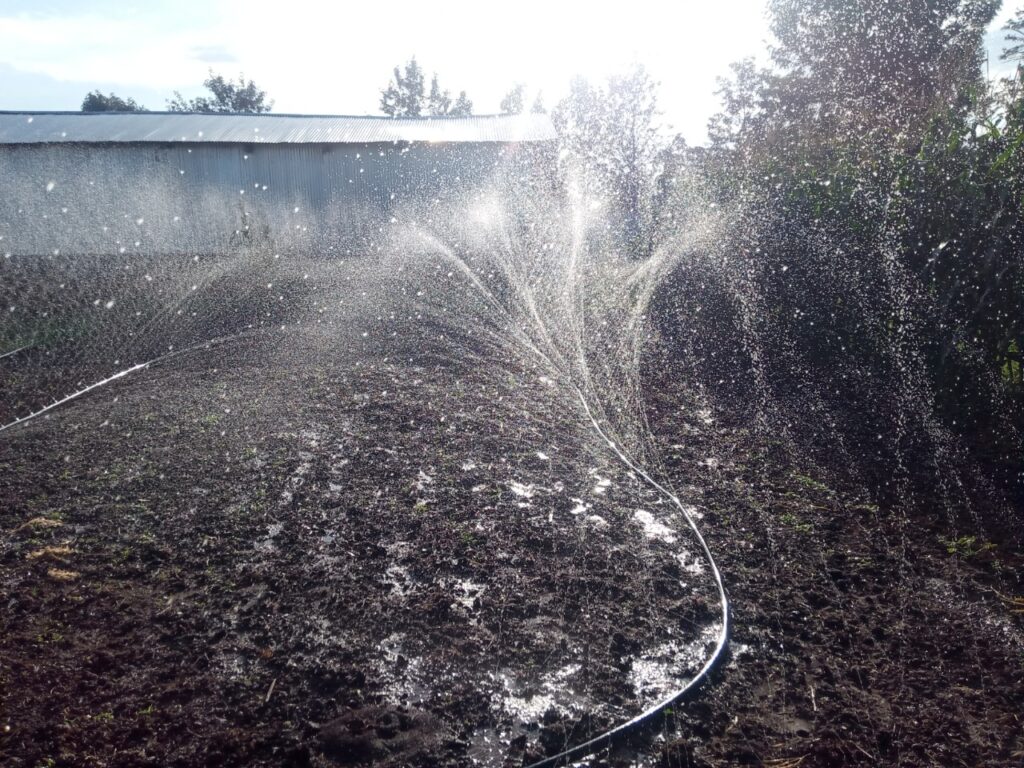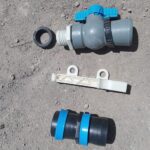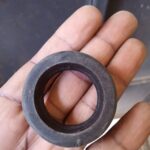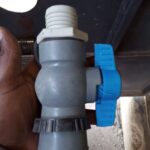Rain Hose Irrigation System

Rain hose irrigation system with nanotechnology punched holes is an affordable irrigation system for overhead irrigation. Rain hose irrigation system uses nano technology to convey water to the plant. It has a series of holes spaced at intervals which sprays water flow by high gravity, or from a water pump is initiated. Our 0.5mm thick, 100M long rain hose pipes are UV treated to last for 10 years in use
Features of a rain hose irrigation system
- It simulates natural rainfall by delivering water to the base of the crop, with the right droplet sizes
- The overhead water is discharged in a 3 dimensional manner; vertically, horizontally, and diagonally
- It is connected directly to a main line
- It is not easily blocked as the water is delivered under high pressure
- The operating pressure is from 15M head / 1.5 bar
Advantages of Grekkon rain hose irrigation pipes
- It is easy to install and maintain, and more economical to install than sprinklers
- It has anti-UV treatment, so it is not easily degraded by the sun
- These spray holes are made with nanotechnology to ensure uniform flow of water
- Irrigate both under gravity flow, and high water pump pressure
- Irrigate an area in just 10 minutes
- Highly portable
- A variety of diameters to select from depending on the farm size
- Tailored free company agronomy support over the first 4 months
- Available from all our 6 outlets country wide in; Athi river, Nairobi, Kisumu, Eldoret, Nyeri, and Nyahururu
Downsides of a rain hose system
- It is less water efficient compared to drip irrigation
- Water loss due to evaporation
- It cannot be used on crops, for intance, crops that are highly susceptible to fugal infections due to foliage wetness
- It requires high operating pressure
- Rainhose are more prone to clogging than large sprinklers because the have tiny emitters
- Under extremely high pressure, the pipes get damaged
Ideal crops for rain hose irrigation system
Crops that can be irrigated using the grekkon rain hose are:
- Vegetable such as carrots, brassicas, potatoes
- Closely spaced bulbs such as onion and garlic
- Fruit tress; avocado, pixie orange, macadamia, coffee
- Agro forestry
- Lawns, gardens, pasture, and football pitches
They are idea for tree or vegetable nursery irrigation
How to install rain hose irrigation pipes
Connecting rain hose pipes is quite simple. All that is needed is a main pipe and fittings. Below is a list of all items required
- HDPE pipes or PVC Pipes as main lines
- Saddle clamps to connect to the main line
- Rain hose off-take (or Ball valves) to connect to the saddle clamp where necessary
- Rain hose end caps to kep the water within the pipe
- Connectors to connect one rain hose pipe to another
- Rain hose pipes to deliver water directly to the crop
Our rain hose pipe is 100M in length. However, a farmer will opt to cut it to lessor lengths according to the irrigation area
Download the rain hose Technical Data Sheet here
Rain hose prices
| Size | Price |
| 32mm (1”) | KES 2,600 |
| 40mm (11/4”) | KES 4,500 |
| 50mm (11/2” ) | KES 5,500 |
The size of the rain hose pipe diameter adopted depends on the area under irrigation. The smaller diameter pipe is ideal for small acreage, while the larger ones will be installed on larger irrigation areas

Rain hose irrigation installed in Eldoret by Grekkon Limited
How to maintain the system
- Ensuring that there is no physical or mechanical damege to the pipes is key is maintaining its lifespan. To achieve this, remove the rain hose pipes from the field when undertaking activities such as; weeding, ploughing, trenching, and levelling
- Use water that has no or with very little suspended particles to reduce the incidences of pores cloggage
- Avoid excessive water pumping pressure which will tear the pipe
- Clean the pipe regularly to remove dirt and debris which may clog it
Consequenses of a poorly maintained system
- Clogging of the emitters which reduces water flow to the crop
- Uneven water distrubution. This will result in uneven crop growth
- Leakages. They cause reduced water flow, or complete ceasation of irrigation
- Low productivity. Due to uneveness of irrigation, and low water provision
- High maintainance costs. repairs and replacements are expensive




